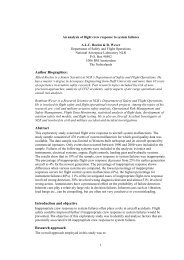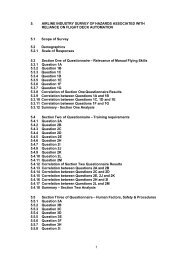Causal risk models of air transport - NLR-ATSI
Causal risk models of air transport - NLR-ATSI
Causal risk models of air transport - NLR-ATSI
Create successful ePaper yourself
Turn your PDF publications into a flip-book with our unique Google optimized e-Paper software.
following 6 levels: Government, Regulator, Company, Management, Staff and Work. The<br />
scope <strong>of</strong> the causal <strong>risk</strong> model should encompass the primary and subsidiary processes<br />
across all hierarchical levels from government down to work.<br />
1.3. Directions for the reader<br />
This thesis starts by explaining very briefly and superficially, the basics that are required<br />
before the research question can be really addressed. A proper discussion on causal<br />
modelling <strong>of</strong> aviation <strong>risk</strong> requires first a definition <strong>of</strong> the concepts <strong>of</strong> <strong>risk</strong> and safety in<br />
Chapter 2 and in Chapter 3 an explanation <strong>of</strong> ‘causality’ in itself, including a description <strong>of</strong><br />
what constitutes a ‘causal model’. User needs are introduced in Chapter 4. The focus then<br />
narrows to current practice beginning in Chapter 5 with a look at the way in which today<br />
safety assessments for <strong>air</strong> <strong>transport</strong> are typically conducted. Chapter 6 follows with an<br />
overview <strong>of</strong> other <strong>risk</strong> bearing industries with particular attention for the way in which <strong>risk</strong><br />
<strong>models</strong> are used in those sectors for managing and controlling <strong>risk</strong>. Comparison <strong>of</strong> current<br />
practice with user needs is decisive in selecting modelling techniques to be used in causal<br />
<strong>risk</strong> <strong>models</strong>. Different techniques and their characteristics are described in Chapter 7.<br />
Quantification is <strong>of</strong>ten mentioned as one <strong>of</strong> the main problems and will be the topic <strong>of</strong><br />
Chapter 8. Three traditionally difficult subjects in <strong>risk</strong> modelling are described in Chapter<br />
9: modelling human operators, modelling safety management and dealing with<br />
interdependencies between various parts <strong>of</strong> the model, while the fourth, validation, is dealt<br />
with in Chapter 10. All the ingredients are then available to come to a conclusion and to<br />
answer the main research question, which is done in Chapter 11. Additional background<br />
information is provided in the Appendices: Appendix A gives an overview <strong>of</strong> the history <strong>of</strong><br />
third party <strong>risk</strong> regulation at Schiphol <strong>air</strong>port. This information is relevant to appreciate the<br />
context from which a call for causal <strong>risk</strong> <strong>models</strong> was explicitly generated. Appendix B<br />
describes the main and subsidiary process in <strong>air</strong> <strong>transport</strong>. Appendix C gives information <strong>of</strong><br />
the CATS project. CATS is used throughout this thesis as an illustration <strong>of</strong> several issues.<br />
11




